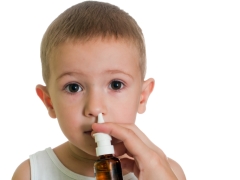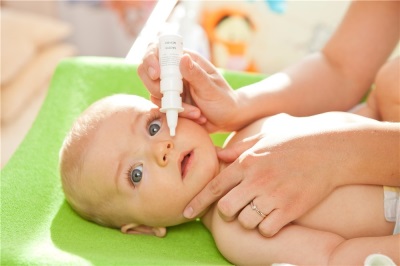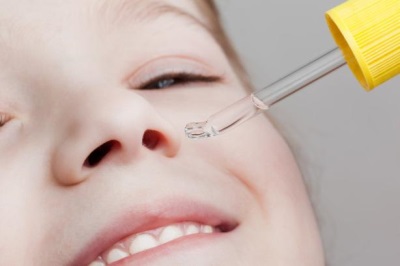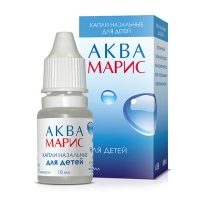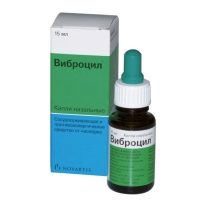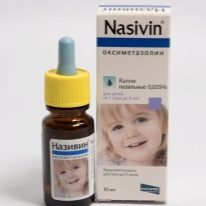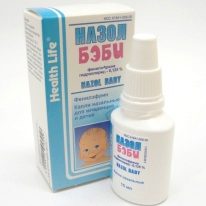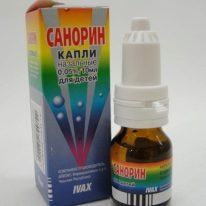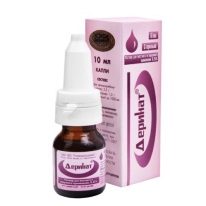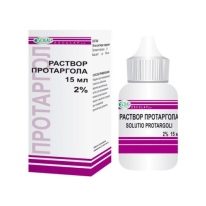Drops from the cold for children
In the treatment of rhinitis, the most popular form of drugs are drops, since they quickly and simply deliver the drug to the desired area. But, if a cold has appeared in a child, it is necessary to choose drops very carefully, since such drugs have both age restrictions, and contraindications, and some nuances of use.
Operating principle
Drops used in the treatment of rhinitis, have such an effect:
- Moisturizing. Such drops help to soften dried mucus, and are also used as a preventive measure for rhinitis.
- Antiviral. Drops with this effect are effective in viral rhinitis at the onset of the disease.
- Vasoconstrictor. The use of such drops eliminates nasal congestion and facilitates breathing. They are often used for rhinitis with a severe course that prevents the child from sleeping and eating.
- Anti-inflammatory. Such drops relieve inflammation in the nasal mucosa.
- Antibacterial. Drops with this effect are indicated for rhinitis caused by bacteria.
- Antiallergic. Such drops are indicated for rhinitis caused by exposure to allergens.
- Immunomodulatory. Drops with this action stimulate the defenses of the child’s body.
Kinds
Depending on the composition and method of manufacturing drops against the common cold are:
- Pharmacy. These are drugs prescribed by doctors and recognized by traditional medicine. Synthetic substances are mainly used for their manufacture.
- Homemade. These are tools that are prepared independently according to popular recipes using natural raw materials.
- Combined. These are drops, for the manufacture of which pharmaceutical components are used at home.
One of the ways of getting rid of the headache in children with the help of traditional medicine is described in the video below.
Remember that you can use self-made medicines only after consulting a pediatrician!
Indications
Drugs in the form of drops are prescribed:
- With a cold headache.
- With allergic rhinitis.
- In chronic form of rhinitis.
- For the prevention of rhinitis during the epidemic season.
- To moisturize and clean the nasal cavity.
- With adenoiditis.
- In acute or chronic sinusitis and otitis.
- For rhinoscopy.
- To prepare for surgical treatment in the nasal area.
- After operations in the nose.
The opinion of the famous doctor Komarosky about how to treat a runny nose in children, see the video:
When not to do without drops?
In many cases, a runny nose is treated without medication, and sometimes it is not treated at all, but there are situations when the use of drops is justified:
- If the child has a broken nasal breathingespecially if there is difficulty in breathing through the mouth.
- At elevated body temperature.
- For earache (timely treatment with vasoconstrictor drops helps prevent otitis media).
Top drops: a review of drugs
Most often in the treatment of rhinitis used such drugs in drops:
- Aquamaris. The main effect of such drops based on sterile seawater is moisturizing mucous. The drug attracts the lack of contraindications and side effects, as well as the possibility of use in infants. It is available in 10 ml vials and is administered from the first day of life, 1-2 drops from 2-3 times a day.
- Vibrocil. Such drops with vasoconstrictor and antiallergic action produced in vials of 15 ml. At the age of one year, the drug is instilled 1 drop 3-4 times a day. For babies older than one year, a single dosage can be increased up to two drops in each nasal passage, and for children over 6 years old - up to 3-4 drops. The drug is not prescribed for atrophic rhinitis. The duration of use without consulting a doctor should not exceed 1 week.
- Otrivin. The active substance of this vasoconstrictor drug is xylometazoline. The drug is available in vials of 10 ml in different concentrations - 0.05% for children under 6 years of age and 0.1% for children over 6 years of age. Means is instilled in 1-2 drops up to 3 times per day for no longer than 1 week.
- Nazivin. The active ingredient of this drug is oxymetazoline, which is noted vasoconstrictor action. For children younger than one year, the drug is released at a concentration of 0.01%, for children from 1 to 6 years old - at a concentration of 0.025%, and children over 6 years old are prescribed a drug with a concentration of 0.05%. The drug is instilled twice or three times a day, 1-2 drops in each nostril, applying the tool no longer than 3-5 days.
- Aqualore Baby. Such moisturizing drops contain sea water. They are produced in 15 ml vials and are administered to both newborns and older children, 1-2 drops in each nostril 2 to 4 times a day.
- Nazol Baby. it vasoconstrictor drops in a 15 ml vial, prescribed for acute rhinitis at the age of one year to 1 drop, and for children 1-6 years, 1-2 drops in each nasal passage. The drug is instilled a maximum of 4 times a day and no longer than 3 days in a row.
- Zyrtec. Such drops containing cetirizine are prescribed at allergic rhinitis.
- Pinosol. The composition of such drops include oils of eucalyptus, pine and mint. Their use has anti-inflammatory, emollient and antibacterial effect. It is often prescribed for the atrophic form of a runny nose, instilling one to two drops in each nostril up to 3 times a day.
- Sanorin. Such vasoconstrictor drops prescribed in children at a concentration of 0.05%, instillation of the drug 2-3 times a day, 1-2 drops in each nasal passage.
- Evkacept. This preparation contains fir, mint and eucalyptus oil, due to which it has anti-inflammatory and antiseptic effect. Means is instilled up to 4 times a day, 1-2 drops in each nostril for 5-7 days.
- Derinat. These are drops with a complex effect on the body, which can be used not only to eliminate the common cold, but also to prevent this disease.
- Protargol. The composition of this drug has silver ions that have antimicrobial action. The medicine is prescribed in 3-5 drops in each nostril twice a day.
Choosing a drug by age
- Choosing drops for newborns and infants up to a year should be especially careful. At this age, the use of Vibrocil, Aquamaris, Otrivin 0.05%, Marimera, Protargola, Nazol Baby, Aqualore Baby. Of folk remedies The most common use of breast milk.
- For the treatment of rhinitis in children from a year you can use drops Nazivin, Zyrtec, sea water based drops, Protargol and Vibrocil. Folk remedies used in children older than a year are onion, aloe, carrot and beet juices. Also often use honey and herbal decoctions.
- For children 2 years, prescribe such drugs in the form of drops, as Tizin 0.05%, Sanorin 0,05%, Pinosol, Eucasept. At this age, the drugs used from birth do not lose their effectiveness, for example, Aqualore, Vibrocil and Aquamaris.
- For children of 3 years old, all those nasal means can be used, which are permissible from birth, from year to year and from two years. Concentrations of such drugs usually do not exceed 0.025-0.05%.
- From the age of 6, drugs are prescribed in higher concentrations, for example, Tizin 0.1% and Nazivin 0.05%. Schoolchildren are also often buried with moisturizing drops, oil preparations, and other products recommended during childhood.
For information on how to treat a runny nose in infants and how to choose drops for older babies, see the interview of Professor E. Otolaryngologist, Doctor of Medical Sciences, pediatric otolaryngologist. Karpovoy.
How to choose good drops?
The main factors that are taken into account in the selection of drops from a cold are the child's age and type of cold, as well as the duration of the disease.. The best tactic would be to contact a doctor who can determine which particular drug will help in a particular case. Safe in childhood drops, which parents can purchase and use on their own, are moisturizers, such as Marimer or Aquamaris. If the mucus in the nozzle is dry, oil drops are shown, for example, Eucasept or Pinosol.
Instructions for use
The drug is instilled alternately in each nostril with a small interval, after removing excess mucus from the nose. To do this, put the baby on the bed and slightly raise the head. When digging in the medicine in the left nasal passage, turn your head slightly to the right, and vice versa. At the end of the procedure, press the wings of the nose and, having seated the child, slightly tilt his head forward.
Visually see how to properly bury drops in the nose of the crumbs, you can in the video:
Tips
- Do not give your child self-vasoconstrictor, antibacterial and antiallergic drops.
- Remember that drops against the common cold are side effects, especially if you use medications with a vasoconstrictor effect. The most frequent of these are sneezing, nasal congestion, dry mucous membranes and a burning sensation. If your child has such symptoms, the use of nasal drops should be discarded.
- Before use Be sure to read the annotation and make sure that your child falls within the age range of using the medication.. Do not exceed the permissible dosage and the recommended duration of use drops.
